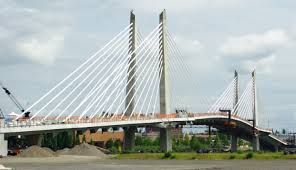The Transportation Research Board (TRB) has released a report, Legal Research Digest 65, which covers Liability Aspects of Pedestrian Facilities. This publication is written for state and local transportation agencies that construct and maintain sidewalks and other pedestrian facilities. Included are claims relating to pedestrian facilities, such as sidewalks and crosswalks. The report focuses on allegations of violations of the Americans with Disabilities Act (ADA) and lawsuits alleging that a government agency has been negligent in maintaining its facilities. The following link leads to a direct download of the report as a .pdf document. http://bit.ly/1OGSRQK
ROAD DIETS ARTICLE FEATURED IN FHWA INNOVATOR MAGAZINE
 The Federal Highway Administration (FHWA) Center for Accelerating Innovation has released a new issue of its bi-monthly Innovator newsletter which includes the article Boost Safety by Going On A Road Diet. The article details examples of positive results in Virginia and Washington state, and also includes a link to a one hour 45 minute presentation about road diets. See http://1.usa.gov/1QyqbIW
The Federal Highway Administration (FHWA) Center for Accelerating Innovation has released a new issue of its bi-monthly Innovator newsletter which includes the article Boost Safety by Going On A Road Diet. The article details examples of positive results in Virginia and Washington state, and also includes a link to a one hour 45 minute presentation about road diets. See http://1.usa.gov/1QyqbIW
PORTLAND, OREGON OPENS NEW MULTI-MODAL VEHICLE BRIDGE
 On September 12th, 2015, Portland, OR opened Tilikum Crossing, the nation’s longest multi-modal vehicle bridge. The bridge serves pedestrians, cyclists, city buses, and light rail service. Private cars and trucks are not permitted on the bridge. Tilikum Crossing is the first major bridge in the U.S. that was designed specifically to allow access to transit vehicles, cyclists, and pedestrians, but not cars. The $135 million, 1,720-foot-long cable-stayed structure is owned by TriMet, the region’s public transit agency. TriMet needed a new way to connect its $1.49 billion Orange Line light rail extension across the river, but the area just south of many of Portland’s Willamette crossings lacked the existing road infrastructure to accommodate a new vehicle-heavy bridge. See more at: http://bit.ly/1kQ2Lm3
On September 12th, 2015, Portland, OR opened Tilikum Crossing, the nation’s longest multi-modal vehicle bridge. The bridge serves pedestrians, cyclists, city buses, and light rail service. Private cars and trucks are not permitted on the bridge. Tilikum Crossing is the first major bridge in the U.S. that was designed specifically to allow access to transit vehicles, cyclists, and pedestrians, but not cars. The $135 million, 1,720-foot-long cable-stayed structure is owned by TriMet, the region’s public transit agency. TriMet needed a new way to connect its $1.49 billion Orange Line light rail extension across the river, but the area just south of many of Portland’s Willamette crossings lacked the existing road infrastructure to accommodate a new vehicle-heavy bridge. See more at: http://bit.ly/1kQ2Lm3
SURVEY: “SHARE THE ROAD” SIGNS INEFFECTIVE
Researchers at North Carolina State University conducted an online survey, reported on the StreetsBlog website, that indicates that the commonly used “Share The Road” signs are ineffective. In a full-length report, “Bicycles May Use Full Lane Signage Communicates U.S. Roadway Rules and Increases Perception of Safety,” George Hess and N. Nils Peterson delve into the background and results of the survey. This is not the first time the effectiveness of “Share The Road” signs have been questioned. Delaware got rid of its “Share the Road” signs about two years ago. They were widely misinterpreted—by both motorists and cyclists—as an exhortation to cyclists to stop “hogging” the road, or as a recommendation that drivers and cyclists share a lane (leading to tight squeezes and close passes). The state dumped the confusing message in favor of a less ambiguous one asserting that bicycles “may use full lane.” Obtain the survey results at: http://bit.ly/1QkLM8K
WALKABILITY’S IMPACT ON HOUSING VALUES, CRIME AND FORECLOSURES
In a new study “Does Walkability Matter? An Examination of Walkability’s Impact on Housing Values, Foreclosures and Crime,” researchers examined 170 neighborhoods in a medium-sized city to see whether walkability influences neighborhood sustainability. Their analysis shows a positive impact not only on neighborhood housing valuation but also on lessened neighborhood crime and foreclosures. These results provide policy opportunities for planners and citizen groups to pursue strategies to encourage the development of more walkable and sustainable neighborhoods. The downloadable .pdf of the study, published in Cities Magazine, Volume 42, Part A, is available for $19.95 at the Science Direct web site: http://bit.ly/1OGUQ7r

